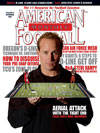AMERICAN FOOTBALL MONTHLY THE #1 RESOURCE FOR FOOTBALL COACHES
Article CategoriesAFM Magazine
|
The Speed Report: Preparing for Football Performance: Proper Warm Upsby: Dale BaskettFootball Speed Specialist © More from this issue One of the more important aspects of practice or game performance is being ready to function mentally and physically. Whether your team is warming up for a practice or a game, certain aspects of readiness (prepared for action) must be applied. When elite athletes perform they are very good at mentally processing variable psychomotor movement activities. When a team takes the field to warm up for practice or a competition, they should approach it with a good mental focus each time. Practice like you play. It begins during the daily warm up series, not just on game day. Physical Preparation: Do It Right To better lend credence to the physiological parameters required to be properly prepared, I’m introducing my long time colleague and mentor, Mike Johnson. He’s one of the nation’s best kept secrets for scientific knowledge and performance application. His background ranges from physiology to kinesiology and biomechanics. He has consulted with a number of Olympic coaches and NFL coaches as well as being a national clinician. Mike’s thoughts on proper football warm-ups: “For too many years, coaching techniques and habits were based on intuition and tradition. Methods for conditioning, strength training, performing drills and teaching X’s and O’s were passed on from coach to coach. Often there was little scientific basis for the information that became the basis for a coach’s belief. For example, at one time or another, one of the fallacies held to be true by many coaches was that static stretching before an athletic event helped reduce the risk of injury and improved athletic performance. “On the other hand, during the last 30 years, a great deal of research from the scientific world has emerged. Several studies have been published confirming that static stretching just prior to (within 15-20 minutes) a dynamic athletic movement can actually cause unfavorable results. For example, athletes that static stretch just prior to a vertical jump test perform worse than they do with no warm up or stretching at all. The actual physiological reasons for the decrease in performance are not fully understood, but it appears that certain mechanisms interfere with motor neuron recruitment patterns, rate coding or some combination of motor neural inhibitions. Obviously, these are not the results coaches expect from a static stretching routine. “Another drawback to flexibility-centered warm up routines involves lack of mental focus, especially with young athletes (middle school and high school). Stretching provides the opportunity for young athletes to talk and talk. The subjects of these conversations range the gamut of life experiences but rarely are concerned with preparing for the imminent practice or competition as Coach Baskett has indicated. “Nearly all coaches are familiar with the concept of warming up before a training session, practice or competition. Many believe stretching should be an integral part of any warm up routine. It’s commonly held that the warm up routine ought to be flexibility centered. But here is an area where current sports research provides data establishing the superiority of dynamic warm up routines to flexibility centered warm ups. “Stretching and warming up are not the same. In stretching, the goal is to increase flexibility (the range of motion around a joint). Increased flexibility is believed to reduce the risk of injury and improve athletic performance. On the other hand, a thorough warm up will increase the core temperature of muscles, enhance oxygen uptake and lower lactate accumulations. Additionally, it will increase muscle pH (which improves the speed and force of muscle contraction), boosts neural impulse transmission speed, decreases muscle, tendon, and ligament viscosity and improves range of motion. “There is no doubt that stretching increases all ranges of motion. All forms of stretching (Static, Ballistic, PNF, Pilates, Yoga, Dynamic) have been shown to increase flexibility. However, several problems arise when stretching is the primary focus of a warm up session. First, more than a half dozen recent studies in sports science show that stretching, especially static stretching does not reduce the potential for injuries in athletics and, in some instances, stretching has a detrimental effect on athletic performance.” So how should athletes warm up to best prepare for a practice or competition? Warm up routines should be dynamic. Here are a few dynamic walk through exercises for your team to utilize: Diagram 1: A walk covering 10-15 yards. Keep the knee as high as possible and walk each step rhythmically.
Diagram 2: This is a walk lifting the leg as high as possible for 10-15 yards. Do not kick the foot but lift the knee straight up while extending the leg. Keep the arms down at the sides.
Diagram 3: As you step forward, arch the back as you drop down. Touch the knees to the ground and come directly back up (10-15 yards).
Diagram 4: Keep arms together and straight downward in front of your body. Lift knees as high as possible in a tuck position behind the shoulder (10-15 yards).
Diagram 5: Lift one foot off the ground slightly while you arch back to warm the groin area (10-15 yards).
Diagram 6: Lift leg as high as possible side straddle while keeping arms in a 90 degree angle (10-15 yards). p
Over the last 27 years, Dale Baskett has trained over 100 NFL players representing every NFL team. This includes 21 All-Pro’s and two members of the Pro Football Hall of Fame. Additionally, he has worked with both high school and college football programs at all levels and resides in San Diego. His progression training systems for teams and players is completely unparalleled anywhere in America. For further information on packages to fit your programs contact him at 858-829-5599 or DBSpeedt@hotmail.com |
|
| HOME |
MAGAZINE |
SUBSCRIBE | ONLINE COLUMNISTS | COACHING VIDEOS |
Copyright 2025, AmericanFootballMonthly.com
All Rights Reserved










